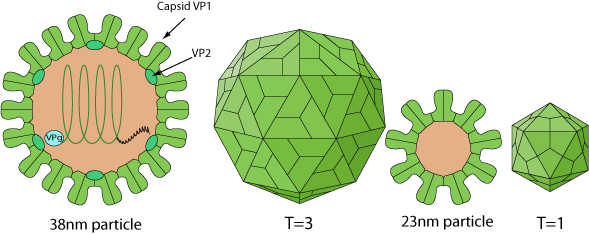VIRION

Non-enveloped, capsid of about 27-40 nm in diameter, with T=3 icosahedral symmetry. The capsid is composed of 180 capsid proteins.
GENOME
Monopartite, linear ssRNA(+) genome of 7.3 to 8.3 kb. The 5'-terminus is linked to a VPg protein and the 3'-terminus has a poly(A) tract.
GENE EXPRESSION
The virion RNA is infectious and serves as both the genome and viral messenger RNA. The genome encodes a polyprotein (ORF1). One or two smaller ORFs are expressed from a subgenomic RNA.
Cleavage of ORF1 polyprotein by the virus-encoded 3C-like cysteine proteinase yields the mature nonstructural proteins. The 3'-end terminal ORF encodes a basic protein (and the capsid protein) and is expressed through RNA termination-reinitiation.
Some Norovirus expressan alternative ORF by leaky scanning
Vesiviruses are apparently unique among the Caliciviridae in that the ORF2 encodes a capsid precursor protein that is proteolytically processed by the viral proteinase to yield the mature capsid protein.
ENZYMES
- RNA-dependent RNA polymerase [RdRp Q83883]
- VPG-type capping [VPg Q83883]
- NTPase-helicase [NTPase Q83883]
- Polyprotein major protease (Peptidase C37) [3CLpro Q83883]
REPLICATION
CYTOPLASMIC
- Attachement to host receptors mediates endocytosis of the virus into the host cell.
- Uncoating, and release of the viral genomic RNA into the cytoplasm.
- VPg is removed from the viral RNA, which is then translated into a processed ORF1 polyprotein to yield the replication proteins.
- Replication occurs in viral factories. A dsRNA genome is synthesized from the genomic ssRNA(+).
- The dsRNA genome is transcribed/replicated thereby providing viral mRNAs/new ssRNA(+) genomes.
- Subgenomic RNA translation gives rise to the capsid protein and VP2.
- Assembly of new virus particles and release by cell lysis.


